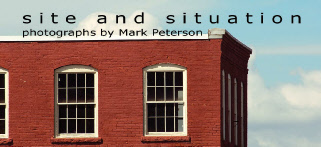Studio 229 -

My intent is to take an ordinary view of a specific, but possibly anonymous, site and expose a hidden composition within it.
Mostly, this is a about framing, which for me is the principle contribution of the photograph. Composition is just not possible with eyesight alone but requires some framing mechanism. I hope to make the composition formally obvious, possibly to the point of absurdity.
If the site is sufficiently banal and the composition sufficiently elegant, then the photograph may be very ironic. To unveil the composition I often use a very long lens which brings shapes up against each other more tightly --an effect I call automatic montage. I find that very early morning light also emphasizes composition by making the lines more definite and by providing more angular shadows.
To place the site in its situation I attempt to make explicit the color of the ambient light, the angle of viewing, and the quality of diffusion of the light. When viewing a scene in person, these elements tend to be ‘computed out’ after looking at any scene for more than a few seconds. The job of the eye-brain is to deliver the real color and real shape of any object and therefore to compensate quickly for the yellowness of the morning light and for quirks of perspective --for instance. In my photographs I try to arrest the earlier, what I consider primary, flash of seeing before these adjustments are made. With a photograph there is an opportunity to capture the situation as first encountered and then to hold it there more or less indefinitely —less practical than usual seeing, but potentially very entertaining.
The particular temperature of light at transition, the beginning or end of the day, is especially fleeting. It evokes not only a specific time but also the moment of reflection in solitude that often accompanies the awareness of this time. Photographs can hold and then multiply these moments.
Mostly, this is a about framing, which for me is the principle contribution of the photograph. Composition is just not possible with eyesight alone but requires some framing mechanism. I hope to make the composition formally obvious, possibly to the point of absurdity.
If the site is sufficiently banal and the composition sufficiently elegant, then the photograph may be very ironic. To unveil the composition I often use a very long lens which brings shapes up against each other more tightly -
To place the site in its situation I attempt to make explicit the color of the ambient light, the angle of viewing, and the quality of diffusion of the light. When viewing a scene in person, these elements tend to be ‘computed out’ after looking at any scene for more than a few seconds. The job of the eye-
The particular temperature of light at transition, the beginning or end of the day, is especially fleeting. It evokes not only a specific time but also the moment of reflection in solitude that often accompanies the awareness of this time. Photographs can hold and then multiply these moments.
About the places
Locations of most of the pictures in the gallery are self-
Hartford City is Hartford City, Indiana, where I grew up.
Karakoy is a village in Turkey, which was essentially abandoned as a result of the 1923 population exchange, a scheme whereby Turks in Greece and Greeks in Turkey were to be exchanged back to their ‘correct’ homeland. (This became known in Greece as the Asia Minor Catastrophe.) A wonderful and terrifying account of this event is Louis de Bernieres’ novel, Birds without Wings.
about